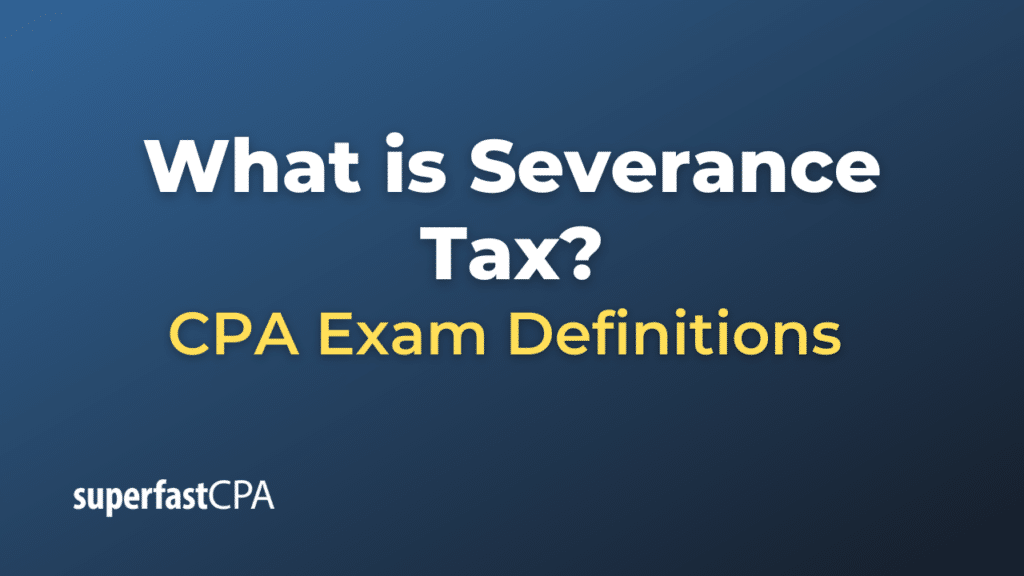Severance Tax
Severance tax is a state or local tax imposed on the extraction of non-renewable natural resources that are intended for consumption in other states or countries. These resources can include oil, gas, coal, timber, and minerals. Essentially, the tax is levied on producers, or anyone who has a right to extract, when these non-renewable resources are “severed” or removed from the earth.
The rationale behind a severance tax is twofold:
- Compensation to the State: Since these resources are non-renewable, once they are extracted and sold, they can’t benefit the state anymore. The tax serves as compensation to the state for the depletion of its natural resources.
- Infrastructure and Environmental Costs: The extraction of natural resources often results in wear and tear on infrastructure, such as roads and bridges. There can also be environmental impacts. The revenue from the severance tax can be used to repair this infrastructure or address environmental concerns related to the extraction process.
Key points about severance taxes:
- Rates Vary: The rate at which resources are taxed varies from one state to another and can also vary based on the specific resource being extracted. For example, the severance tax rate for oil might be different from the rate for coal within the same state.
- Deductions and Exemptions: Some states allow for certain deductions or exemptions from the severance tax. For instance, costs related to transportation or processing might be deductible.
- Use of Revenue: The way in which severance tax revenue is used can vary by state. Some states might use the revenue for general fund purposes, while others might allocate it to specific causes, such as environmental conservation, education, or infrastructure improvement.
- Impact on Local Economies: While severance taxes provide revenue to states, there’s a debate about their impact on local economies. Some argue that they discourage production or investment in extraction activities, while others believe they ensure that states are fairly compensated for the loss of non-renewable resources.
To understand the specifics of how a severance tax operates, one would need to refer to the statutes and regulations of the particular state imposing the tax.
Example of Severance Tax
Let’s delve into a hypothetical scenario involving an oil production company and a state’s severance tax.
State: PetroLand
Resource: Crude Oil
Severance Tax Rate for Crude Oil: 5% of the market value
Scenario:
Omega Oil Co. has drilling operations in PetroLand. Over a given month, they extract 100,000 barrels of crude oil. At the time of extraction, the market value of crude oil is $50 per barrel.
Severance Tax Calculation:
- Total Market Value of Extracted Oil:
- 100,000 barrels x $50/barrel = $5,000,000
- Severance Tax Owed:
- 5% of $5,000,000 = $250,000
So, for that month, Omega Oil Co. would owe PetroLand a severance tax of $250,000.
Additional Considerations:
- Deductions: PetroLand allows a deduction for transportation costs associated with getting the crude oil to market. If Omega Oil Co. has transportation costs of $100,000 for the month, their taxable amount would be $5,000,000 – $100,000 = $4,900,000. Therefore, their revised severance tax would be 5% of $4,900,000, which equals $245,000.
- Use of Revenue: PetroLand uses the revenue from the severance tax to fund environmental conservation programs and to maintain roads in the state that are heavily used by the oil and gas industry. Of the $245,000 collected from Omega Oil Co., $150,000 might go to conservation efforts, and $95,000 might go to road maintenance.
- Long-Term Implications: If the price of crude oil drops to $30 per barrel the following month, Omega Oil Co.’s severance tax would decrease even if they extract the same amount of oil. Conversely, if they increase their production or if the price of oil rises, their tax could increase.
This example provides a snapshot of how severance taxes work and the factors influencing the amount of tax paid by a company. The real-world calculations might be more complex, given the various deductions, exemptions, and changing market conditions.














